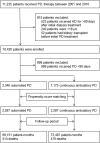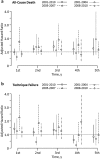Do Automated Peritoneal Dialysis and Continuous Ambulatory Peritoneal Dialysis Have the Same Clinical Outcomes? A Ten-year Cohort Study in Taiwan
- PMID: 27388055
- PMCID: PMC4937348
- DOI: 10.1038/srep29276
Do Automated Peritoneal Dialysis and Continuous Ambulatory Peritoneal Dialysis Have the Same Clinical Outcomes? A Ten-year Cohort Study in Taiwan
Abstract
This paper reports a comprehensive comparison for mortality and technique failure rates between automated peritoneal dialysis (APD) and continuous ambulatory peritoneal dialysis (CAPD) in Taiwan. A propensity-score matched cohort study was conducted by retrieving APD and CAPD patients identified from the Taiwan National Health Insurance Research Database between 2001 and 2010. The main outcomes were the 5-year mortality and technique failure rates. Further analyses were then carried out based upon the first (2001-2004), second (2005-2007), and third (2008-2010) sub-periods. Similar baseline characteristics were identified for APD (n = 2,287) and CAPD (n = 2,287) patients. The proportion on APD therapy increased rapidly in the second sub-period. As compared to CAPD patients of this sub-period, APD patients had a significantly higher risk of mortality (HR, 1.37; 95% CI 1.09-1.72; p < 0.01) and technique failure (HR, 1.43; 95% CI, 1.10-1.86; p < 0.01), particularly in the first year after peritoneal dialysis commencement. However, APD patients had similar mortality and technique failure rates to those of CAPD patients throughout the full sample period and the first and third sub-periods. These findings do not suggest the presence of a clear advantage of CAPD over APD. Differences observed between these two modalities might be attributed to specials circumstances of sub-periods.
Figures




References
-
- Mehrotra R., Chiu Y. W., Kalantar-Zadeh K., Bargman J. & Vonesh E. Similar outcomes with hemodialysis and peritoneal dialysis in patients with end-stage renal disease. Arch Intern Med. 171, 110–118 (2011). - PubMed
-
- Chang Y. K. et al. A comparative assessment of survival between propensity score-matched patients with peritoneal dialysis and hemodialysis in Taiwan. Medicine (Baltimore) 91, 144–151 (2012). - PubMed
-
- Yang W. C. & Hwang S. J. Incidence, prevalence and mortality trends of dialysis end-stage renal disease in Taiwan from 1990 to 2001: the impact of national health insurance. Nephrol Dial Transplant 23, 3977–3982 (2008). - PubMed
-
- U. S. Renal Data System, USRDS 2013 Annual Data Report: Atlas of Chronic Kidney Disease and End-Stage Renal Disease in the United States, National Institutes of Health, National Institute of Diabetes and Digestive and Kidney Diseases, Bethesda, MD, 2013, Available at: http://www.usrds.org/atlas.aspx. (Accessed: 28 th June 2014).
Publication types
MeSH terms
LinkOut - more resources
Full Text Sources
Other Literature Sources
Research Materials

